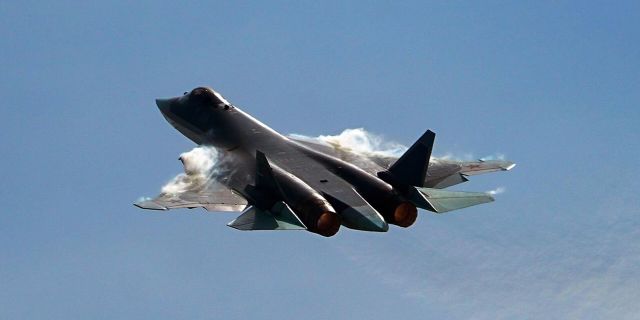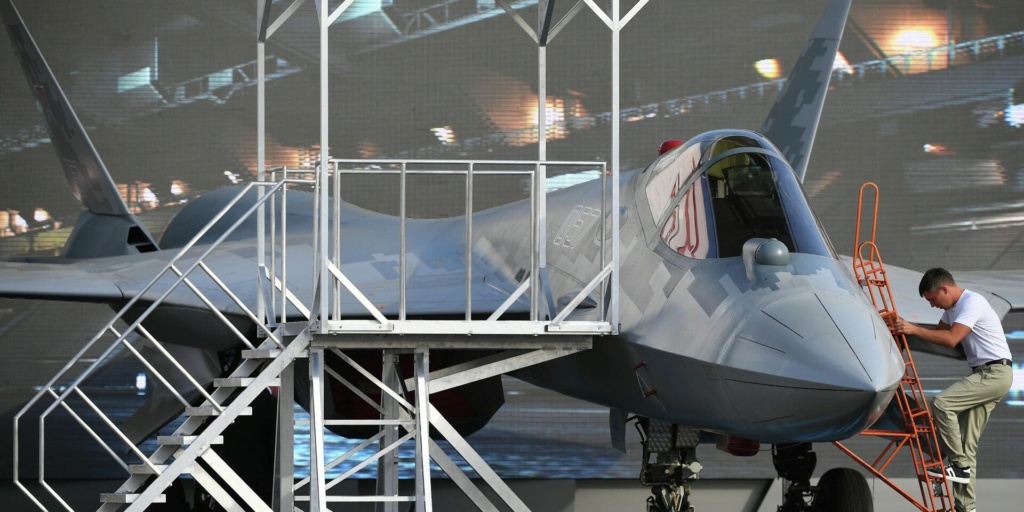09/27/2022
InoSMI
Russia has found new ways to use the Su-57
Will Russia be able to implement the plan for a future aircraft carrier based on the Su-57 with an electromagnetic catapult ?* Recently, Russia presented a mock-up of a warship carrying a modified Su-57 with an electromagnetic catapult, Sohu user writes. The new version of the fighter would allow her to strengthen the fleet at minimal cost. But there is one thing, the author notes.
Not so long ago, Russia presented a model of the future aircraft carrier. Interestingly, the carrier-based aircraft for this vessel is actually a model of a sea-based Su-57 fighter, whose launch is carried out using the most advanced electromagnetic catapult technology. Currently, the only aircraft carrier operating in Russia is the obsolete Admiral Kuznetsov, which uses a springboard deck. Moreover, Russian Defense Minister Sergei Shoigu said that the Navy would train naval aviation in the use of electromagnetic catapults. Is it possible to implement this technology? What aircraft carrier does the Russian Federation really need?
At the moment, the smallest aircraft carrier in the world is considered to be a multipurpose universal landing ship (UDC) with a displacement of up to 40,000 tons. In general, this so-called aircraft carrier is a multi-purpose warship converted from UDC. Its springboard deck is used for aircraft takeoffs and landings, and landing vehicles can be transported inside. In addition to VTOL fighters, helicopters are the main carrier-based aircraft of the UDC. The reason why this type of ship can also be considered an aircraft carrier is that the United States has recently completed the construction of the F-35B fighter. If other countries can buy sea-based F-35Bs and upgrade the decks of their UDCs a little, then landing ships will be able to carry them.
Take the UK, for example: its Queen Elizabeth-class aircraft carrier has an F-35B take-off deck and a vertical landing deck, making the process much easier. In addition, many countries, such as Italy, Spain, France, South Korea and Japan, can build amphibious ships with a displacement of less than 40 thousand tons, so buying an advanced F-35B will allow them to fulfill their dream of an aircraft carrier. This is the same situation as when a small-tonnage aircraft carrier was upgraded to a carrier-based Hawker Sea Harrier fighter. It is not difficult for Russia to build a light aircraft carrier with a displacement of less than 40,000 tons. The main problem is that Russia does not have a proven and reliable VTOL fighter, so this option does not suit her. An aircraft carrier with an electromagnetic catapult and a flat deck with a displacement of more than 60,000 tons would be a worthy vessel of a powerful military power. The installation of an electromagnetic catapult will increase the efficiency of launching carrier-based aircraft, incomparable with an aircraft carrier with a springboard deck. But the problem is that it is very difficult to develop such a catapult. China and the United States were able to create it only after many years of in-depth research.In addition, in terms of time, this technology is not yet "ripe", its reliability is still incomparable with the previous steam catapult, it has to go through a lot of experiments and test launches.
As for the speed of development, in the next few years or even decades in Russia it will be almost impossible to introduce and practically apply the technology of an electromagnetic catapult. Just like China did with the Type 003 aircraft carrier, Russia knows that building this technology in a short amount of time is unrealistic. There is only one possibility for this: Moscow will try to get developments from Beijing. However, this is the most advanced military technology, whose export is also unlikely.
Thus, Russia cannot turn to the latest developments and does not want to turn to outdated ones. Can she choose the middle ?The country's main carrier-based aircraft is the modernized MiG-29K, its positioning system is similar to that of the US Navy's Super Hornet fighter, but it is inferior in actual performance. If Russia makes a carrier-based version of the Su-57 and puts it into service, it could theoretically become an improved replacement for the MiG-29K. The Su-57 is a dedicated air-to-air anti-aircraft aircraft that can carry heavy weapons for land and sea attacks. The MiG-29K was originally a medium-sized fighter with a fairly large takeoff weight and high impact characteristics. While it doesn't compare to China's J-35s and upgraded J-15s, it's still not bad.
Most importantly, whether it's the MiG-29K or the previous Su-33 carrier-based aircraft, Russia does have a wealth of experience in deploying ski-jump deck aircraft carriers. The Su-33 fighter is larger in size and weight than the Su-57. For years, Moscow has successfully used the Su-33, proving that a 60,000-ton aircraft carrier like the Admiral Kuznetsov can carry and launch fighter jets. If you create a deck version of the Su-57, there will be no need to greatly upgrade the carrier ship, and then the springboard deck will fully reveal almost all the capabilities of the fighter. Thus, Russia will get a good aircraft carrier with minimal costs and difficulties.
Some time ago, Russia announced that it wants to make a deck model of the Su-57. It can modernize the Admiral Kuznetsov and get an advanced aircraft carrier with a flat deck and a displacement of about 60,000 tons. First of all, it will significantly reduce the cost and complexity of its construction. Secondly, only two carrier-based aircraft guarantee its basic combat capability - especially if one of them is the Su-57.
Of course, at this stage, one should not have too high hopes for the deck combination of the Su-57 or MiG-29K - this is still just an idea. With a handful of 20,000-ton amphibious assault ships capable of carrying enough drones and helicopters, Moscow will already bolster the Navy pretty well. Competing with America for hegemony at sea is just a dream. To be able to defend their territories and resist Europe is already a great feat.
Author: Lu Zhi
https://vpk.name/news/634889_rossiya_nashla_novye_sposoby_ispolzovaniya_su-57.html


 sepheronx
sepheronx






